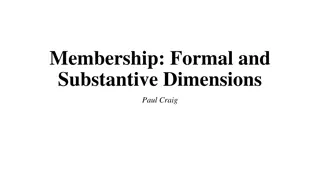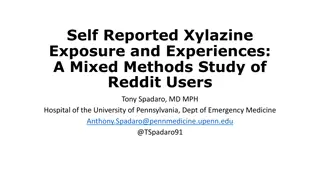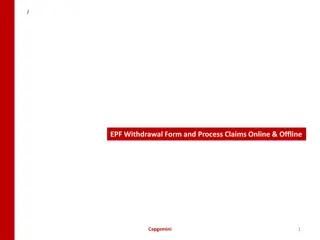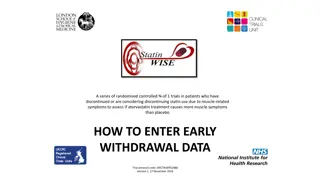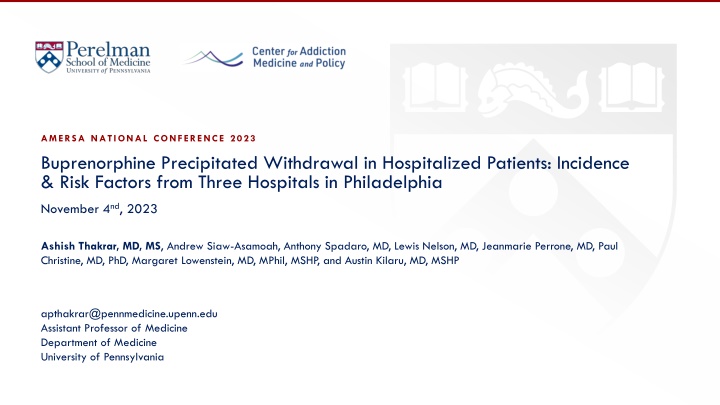
Buprenorphine Precipitated Withdrawal in Hospitalized Patients: Incidence & Risk Factors
This presentation at the AMERSA National Conference 2023 discusses the incidence and risk factors of buprenorphine precipitated withdrawal (PW) in hospitalized patients in Philadelphia. The study aims to estimate PW incidence at three hospitals, explore risk factors, and details the methods used in the retrospective cohort study. Despite initial fears, recent studies show low PW rates, prompting further investigation into the phenomenon.
Download Presentation

Please find below an Image/Link to download the presentation.
The content on the website is provided AS IS for your information and personal use only. It may not be sold, licensed, or shared on other websites without obtaining consent from the author. If you encounter any issues during the download, it is possible that the publisher has removed the file from their server.
You are allowed to download the files provided on this website for personal or commercial use, subject to the condition that they are used lawfully. All files are the property of their respective owners.
The content on the website is provided AS IS for your information and personal use only. It may not be sold, licensed, or shared on other websites without obtaining consent from the author.
E N D
Presentation Transcript
AMERSA NATIONAL CONFERENCE 2023 Buprenorphine Precipitated Withdrawal in Hospitalized Patients: Incidence & Risk Factors from Three Hospitals in Philadelphia November 4nd, 2023 Ashish Thakrar, MD, MS, Andrew Siaw-Asamoah, Anthony Spadaro, MD, Lewis Nelson, MD, Jeanmarie Perrone, MD, Paul Christine, MD, PhD, Margaret Lowenstein, MD, MPhil, MSHP, and Austin Kilaru, MD, MSHP apthakrar@pennmedicine.upenn.edu Assistant Professor of Medicine Department of Medicine University of Pennsylvania
Disclosures No disclosures or conflicts of interest Incidence of Buprenorphine Precipitated Withdrawal in Hospitalized Patients AMERSA 2023 Annual Conference | Ashish Thakrar apthakrar@pennmedicine.upenn.edu
Background Increased reports of buprenorphine precipitated withdrawal (PW) Patients report PW despite 12-48h abstinence from fentanyl.1 Case reports: PW despite initial COWS >13.2,3 In Philadelphia: most are declining traditional/high dose initiation due to fear of buprenorphine PW Yet two recent studies found very low incidence of PW: D Onofrio (2023): Among 897 fent+, PW incidence 1.0% o Initiation: 8mg SL once COWS>8 Snyder (2023): Of 87 reported fent. use in CA, PW incidence 4.5% o Initiation: 8-16mg SL Incidence of Buprenorphine Precipitated Withdrawal in Hospitalized Patients AMERSA 2023 Annual Conference | Ashish Thakrar apthakrar@pennmedicine.upenn.edu 1.Varshneya (2021); 2.Shearer (2021); 3.Spadaro (2023); 4.Weimer (2023); 5.Thakrar (2023)
Aims Incidence 1 Aim 1: Estimate PW incidence at 3 hospitals in Philadelphia with traditional or high dose induction (2-16mg once COWS >8) Risk Factors 2 Aim 2: Explore possible risk factors for PW Incidence of Buprenorphine Precipitated Withdrawal in Hospitalized Patients AMERSA 2023 Annual Conference | Ashish Thakrar apthakrar@pennmedicine.upenn.edu
Methods: Design, Setting, and Cohort Retrospective cohort study using EHR review of 3 urban academic hospitals in Philadelphia, PA over 24 months (1/2020 - 12/2021) Inclusion criteria: o OUD (by ICD-10, naloxone admin, or ED chief complaint) o Traditional initiation: COWS >8 before first buprenorphine First buprenorphine dose: >2mg SL (excluding LDI, XR-BUP) Exclusion: o Missing COWS documentation <4h after buprenorphine Incidence of Buprenorphine Precipitated Withdrawal in Hospitalized Patients AMERSA 2023 Annual Conference | Ashish Thakrar apthakrar@pennmedicine.upenn.edu
Methods: Outcome & Exposures Primary outcome: precipitated withdrawal (PW) Definition: rise in COWS >51,2within 4h after buprenorphine o Sensitivity analysis: peak COWS within 2h after buprenorphine Exploratory analysis of risk factors for PW (using logistic regression): 1. Higher initial doses3 2. Lower pre-bup COWS4 3. Higher BMI5 4. Higher urine fentanyl/norfentanyl concentration(if UDT)6 1.D Onofrio (2023); 2.Dunn (2023); 3.Rosado (2007); 4.SAMHSA (2021); 5. Luba (2022); 6. Thakrar (2023) Incidence of Buprenorphine Precipitated Withdrawal in Hospitalized Patients AMERSA 2023 Annual Conference | Ashish Thakrar apthakrar@pennmedicine.upenn.edu
Limitations & Strengths Limitations of this approach: Who accepts these buprenorphine initiations? Who has COWS documented after buprenorphine? Strengths of this approach: Real-world setting Did not have to meet clinical trial inclusion criteria Incidence of Buprenorphine Precipitated Withdrawal in Hospitalized Patients AMERSA 2023 Annual Conference | Ashish Thakrar apthakrar@pennmedicine.upenn.edu
Results: Flow Diagram & PW Incidence 375 Traditional initiations 149 Missing COWS <4h after buprenorphine Mean age 38.6, 34% female, 57% White, 68% Medicaid, 38% OUD dx PW incidence: 11.5% (26/226) o [COWS with 2h]: 12.9% (18/140) 226 Traditional initiation & COWS documented <4h after buprenorphine Incidence of Buprenorphine Precipitated Withdrawal in Hospitalized Patients AMERSA 2023 Annual Conference | Ashish Thakrar apthakrar@pennmedicine.upenn.edu
Results: Clinical Risk Factors for PW All Traditional Inductions PW No PW n = 200 (88.5%) p-value n = 26 (11.5%) Initial dose 2mg SL 4mg SL 8mg SL >12mg SL
Results: Clinical Risk Factors for PW All Traditional Inductions PW No PW n = 200 (88.5%) p-value n = 26 (11.5%) Initial dose 2mg SL 4mg SL 8mg SL >12mg SL 0.271 2 (6.5%) 29 (93.5%) 16 (11.0%) 129 (89.0%) 8 (17.4%) 38 (82.6%) 0 (0%) 4 (100%)
Results: Clinical Risk Factors for PW All Traditional Inductions PW No PW n = 200 (88.5%) p-value n = 26 (11.5%) Initial dose 2mg SL 4mg SL 8mg SL >12mg SL COWS before bup 0.271 2 (6.5%) 29 (93.5%) 16 (11.0%) 129 (89.0%) 8 (17.4%) 38 (82.6%) 0 (0%) 4 (100%) 0.497 COWS 8-12 COWS >13 15 (10.4%) 129 (89.6%) 11 (13.4%) 71 (86.6%)
Results: Clinical Risk Factors for PW All Traditional Inductions PW No PW n = 200 (88.5%) p-value n = 26 (11.5%) Initial dose 2mg SL 4mg SL 8mg SL >12mg SL COWS before bup 0.271 2 (6.5%) 29 (93.5%) 16 (11.0%) 129 (89.0%) 8 (17.4%) 38 (82.6%) 0 (0%) 4 (100%) 0.497 COWS 8-12 COWS >13 15 (10.4%) 129 (89.6%) 11 (13.4%) 71 (86.6%) BMI 0.150 <18.5 18.5-25 25-30 >30 0 (0%) 11 (100%) 12 (10.9%) 98 (89.1%) 8 (11.0% 65 (89.0%) 6 (18.8%) 26 (81.2%)
Results: Case Characteristics & PW Incidence 375 Traditional initiations 149 Missing COWS <4h after buprenorphine 226 Traditional initiation & COWS <4h after buprenorphine 56 47 UDT not sent Fentanyl/norfentanyl absent on UDT 123 Traditional initiation, withdrawal documented, & confirmed fentanyl use PW incidence: 16.3% (20/123) Incidence of Buprenorphine Precipitated Withdrawal in Hospitalized Patients AMERSA 2023 Annual Conference | Ashish Thakrar apthakrar@pennmedicine.upenn.edu
Results: Clinical Risk Factors for PW All Traditional Inductions Fent. or Norfent. Detected PW No PW n = 200 (88.5%) p-value PW No PW n = 103 (83.7%) p-value n = 26 (11.5%) n = 20 (16.3%) Initial dose 2mg SL 4mg SL 8mg SL >12mg SL COWS before bup 0.271 0.333 2 (6.5%) 29 (93.5%) 16 (11.0%) 129 (89.0%) 8 (17.4%) 38 (82.6%) 0 (0%) 2 (9.5%) 19 (90.5%) 13 (16.3%) 67 (83.7%) 5 (25.0%) 15 (75.0%) 0 (0%) 4 (100%) 2 (100%) 0.497 0.364 COWS 8-12 COWS >13 15 (10.4%) 129 (89.6%) 11 (13.4%) 71 (86.6%) 12 (14.8%) 69 (85.2%) 8 (19.0%) 34 (81.0%) BMI 0.150 0.017 <18.5 18.5-25 25-30 >30 0 (0%) 11 (100%) 0 (0%) 7 (11.9%) 52 (88.1%) 7 (18.4%) 31 (81.6%) 6 (33.3%) 12 (66.7%) 8 (100%) 12 (10.9%) 98 (89.1%) 8 (11.0% 65 (89.0%) 6 (18.8%) 26 (81.2%)
Results: Fentanyl Concentration in Urine as a Risk Factor for PW PW No PW n = 148 (%) p-value* n = 22 Fentanyl Not present 1-500 ng/mL >500 ng/mL Norfentanyl Not detected 1-1000 ng/mL >1000 ng/mL
Results: Fentanyl Concentration in Urine as a Risk Factor for PW PW No PW n = 148 (%) p-value* n = 22 0.014 Fentanyl Not present 1-500 ng/mL >500 ng/mL Norfentanyl Not detected 1-1000 ng/mL >1000 ng/mL 2 49 87 12 (3.9) (15.5) (25.0) 16 4 0.006 2 5 45 51 52 (4.3) (8.9) (22.4) 15
Conclusions, Limitations, and Next Steps Conclusions: Among 226 traditional or high dose buprenorphine initiations at 3 hospitals in Philadelphia, PW incidence ranged from 11.5-16.3% Future studies should explore whether higher BMI and higher fentanyl/norfentanyl concentrations predict risk for PW Limitations: Retrospective, Philadelphia, did not correct for multiple comparisons Risk of bias: Who accepted bup? Who had COWS documented? Next steps: Funded R34 will prospectively test PW ~ fent/norfent concentration Incidence of Buprenorphine Precipitated Withdrawal in Hospitalized Patients AMERSA 2023 Annual Conference | Ashish Thakrar apthakrar@pennmedicine.upenn.edu
Questions & Discussion Xylazine Testing & Withdrawal Among Hospitalized Patients in Philadelphia SGIM 2023 Annual Conference | Ashish Thakrar apthakrar@pennmedicine.upenn.edu
CITATIONS 1. Varshneya NB, Thakrar AP, Hobelmann JG, Dunn KE, Huhn AS. Evidence of Buprenorphine-precipitated Withdrawal in Persons Who Use Fentanyl. Journal of Addiction Medicine. 2021; doi:10.1097/ADM.0000000000000922 Shearer D, Young S, Fairbairn N, Brar R. Challenges with buprenorphine inductions in the context of the fentanyl overdose crisis: A case series. Drug Alcohol Rev. Published online October 13, 2021:dar.13394. doi:10.1111/dar.13394 Spadaro A, Faude S, Perrone J, et al. Precipitated opioid withdrawal after buprenorphine administration in patients presenting to the emergency department: A case series. JACEP Open. 2023;4(1). doi:10.1002/emp2.12880 Weimer MB, Herring AA, Kawasaki SS, Meyer M, Kleykamp BA, Ramsey KS. ASAM Clinical Considerations: Buprenorphine Treatment of Opioid Use Disorder for Individuals Using High-potency Synthetic Opioids. J Addict Med. Published online July 28, 2023. doi:10.1097/ADM.0000000000001202 Thakrar AP, Faude S, Perrone J, et al. Association of Urine Fentanyl Concentration With Severity of Opioid Withdrawal Among Patients Presenting to the Emergency Department. J Addict Med. 2023;Publish Ahead of Print. doi:10.1097/ADM.0000000000001155 2. 3. 4. 5. Incidence of Buprenorphine Precipitated Withdrawal in Hospitalized Patients AMERSA 2023 Annual Conference | Ashish Thakrar apthakrar@pennmedicine.upenn.edu
Results: Clinical Risk Factors for PW All Traditional Inductions No PW n = 26 n = 200 Fent. or Norfent. Detected No PW n = 20 n = 103 PW (%) (11.5) p-value PW (%) (16.3) p-value Initial dose 2mg SL 4mg SL 8mg SL >12mg SL COWS before bup COWS 8-12 COWS >13 Door to bup time <24h 24-48h >48h BMI <18.5 18.5-25 25-30 >30 0.271 0.333 2 29 (6.5) 2 19 67 15 (9.5) (16.3) (25.0) (0.0) 16 129 (11.0) 38 (17.4) 4 13 8 0 5 0 (0.0) 2 0.497 0.364 15 11 129 (10.4) 71 (13.4) 12 69 34 (14.8) (19.0) 8 0.345 0.250 21 149 (12.4) 30 (11.8) 21 16 70 20 13 (18.6) (13.0) (7.1) 4 1 3 1 (4.5) 0.150 0.017 0 11 98 (10.9) 65 (11.0) 26 (18.8) (0.0) 0 7 7 6 8 (0.0) (11.9) (18.4) (33.3) 12 52 31 12 8 6
Results: Fentanyl Concentration in Urine as a Risk Factor for PW PW No PW n = 148 (%) p-value* n = 22 0.014 Fentanyl Not present 1-500 ng/mL >500 ng/mL Norfentanyl Not detected 1-1000 ng/mL >1000 ng/mL Methadone Not detected Detected Buprenorphine Not detected Detected Naloxone Not detected Detected 2 49 87 12 (3.9) (15.5) (25.0) 16 4 0.006 2 5 45 51 52 (4.3) (8.9) (22.4) 15 0.622 21 1 137 11 (13.3) (8.3) 0.098 19 141 (11.9) (30.0) 3 7 0.257 19 138 10 (12.1) (23.1) 3






